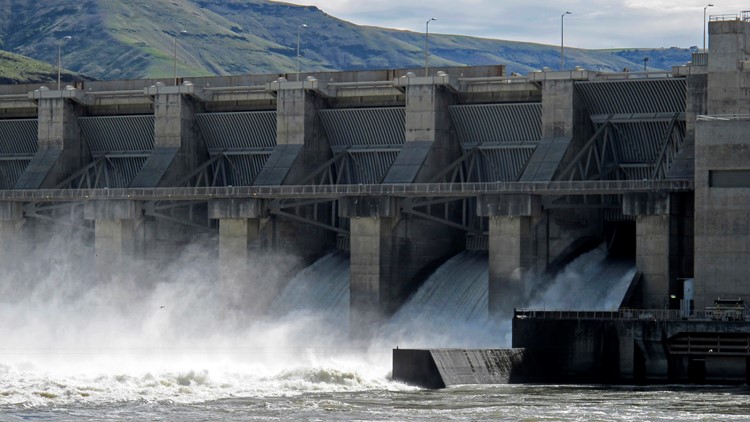SPOKANE, Wash. — The benefits provided by four giant hydroelectric dams on the Snake River must be replaced before the dams can be breached to save endangered salmon runs, according to a final report issued Thursday by Washington Gov. Jay Inslee and Washington U.S. Sen. Patty Murray.
That is especially true regarding the reliable and carbon-free electricity the dams generate, the report concluded.
If the four Snake River dams were ultimately removed, it would be the largest such project in U.S. history. In 2012 the Elwha Dam on Washington state’s Olympic Peninsula was removed to restore habitat. At the time, the National Park Service said the elimination of the Elwha Dam was the largest such project in U.S. history.
Congress will ultimately decide if the federally-owned dams will be removed, and would have to appropriate money for the work.
The issue is not a matter of electricity versus salmon, Thursday's report said.
“We believe that is an oversimplified binary choice, and it is one that we do not accept or see as inevitable,” Inslee and Murray wrote.
But, “the science is clear that – specific to the Lower Snake River – breach of the dams would provide the greatest benefit to the salmon,” the report said.
Breaching the dams would significantly improve the ability of salmon and steelhead to swim from their inland spawning grounds to the Pacific Ocean, where they spend most of their lives, and then back to their original spawning grounds to procreate and die, the report said.
Major benefits of the dams besides electricity include making the Snake River navigable up to Lewiston, Idaho, allowing barges to carry wheat and other crops to ocean ports. Eliminating the dams would require truck and rail transportation improvements to move crops, the report said. The dams also provide irrigation water for farmers and recreation opportunities for people.
A draft report released on June 9 concluded the benefits provided by the dams would cost between $10.3 billion and $27.2 billion to replace.
The dams have many supporters, including two GOP members of Congress representing eastern Washington state, where the dams are located. The dams are also supported by barge companies, farmers and other business interests.
Republican U.S. Reps. Dan Newhouse and Cathy McMorris Rodgers recently introduced a bill to protect the dams.
But the chairman of the Yakama Nation has said the dams must be breached.
“Our people are salmon people,” tribal council chairman Delano Saluskin said earlier this year. “When the salmon thrive, we thrive; but when they suffer, our people suffer too.”
Exploring the Columbia River Basin in 1805, Lewis and Clark wrote of waterways so full with salmon that you could all but walk across on their backs.
In the late 1800s, up to 16 million salmon and steelhead returned to the Columbia River Basin every year to spawn. Over the next century and a half, overfishing whittled that number down. By the early 1950s, just under 130,000 Chinook were returning to the Snake River.
Construction of the first dam on the lower river, Ice Harbor, began in 1955. Lower Monumental followed in 1969, Little Goose in 1970, and Lower Granite in 1975. The dams stretch from Pasco, Washington, to near Pullman, Washington, and stand between migrating salmon and 5,500 miles (8,850 kilometers) of spawning habitat in central Idaho.
The dams have fish ladders, but too many of the salmon die as they swim through the dams and across slackwater reservoirs on their migrations.
In 1991, Snake River salmon and steelhead were listed as endangered species, requiring production of a federal recovery plan. Over the next three decades, environmental organizations sued the federal government six times, arguing that the recovery plan was inadequate.
The most recent lawsuit, in 2016, resulted in a four-year study of the environmental impact of the dams. Although it found that breaching the dams would be the most effective salmon recovery action, federal agencies ultimately decided against it.
The U.S. government has spent more than $17 billion trying to recover Snake River salmon, through improvements to fish ladders and other measures, with little to show for it. In 2017, the number of Chinook salmon returning to the Snake River dropped below 10,000.
Dam supporters blame declining salmon runs on other factors, such as changing ocean conditions.
Inslee and Murray said there are “clear areas of common agreement.”
“People of every perspective share a desire to see progress on the underlying issues and relief from the uncertainty created by litigation,” the report said.
Inslee and Murray said it is clear that, with adequate money, it is possible to replace most of the services and benefits provided by the dams and to mitigate the loss of others.
Government must move forward to provide replacements for the benefits of the dams “so that breaching of the Lower Snake River Dams is a pathway that can be credibly considered by policymakers in the future," the report said.
Going forward, Inslee and Murray committed to:
—Substantially expand salmon habitat and passage throughout the Columbia River Basin and the Puget Sound.
—Improve the siting process necessary to build the clean energy resources needed.
—Leverage the investments made in the Biden administration's Infrastructure Investment and Jobs Act and the Inflation Reduction Act to support energy replacement, infrastructure enhancement, and salmon recovery and habitat restoration.



